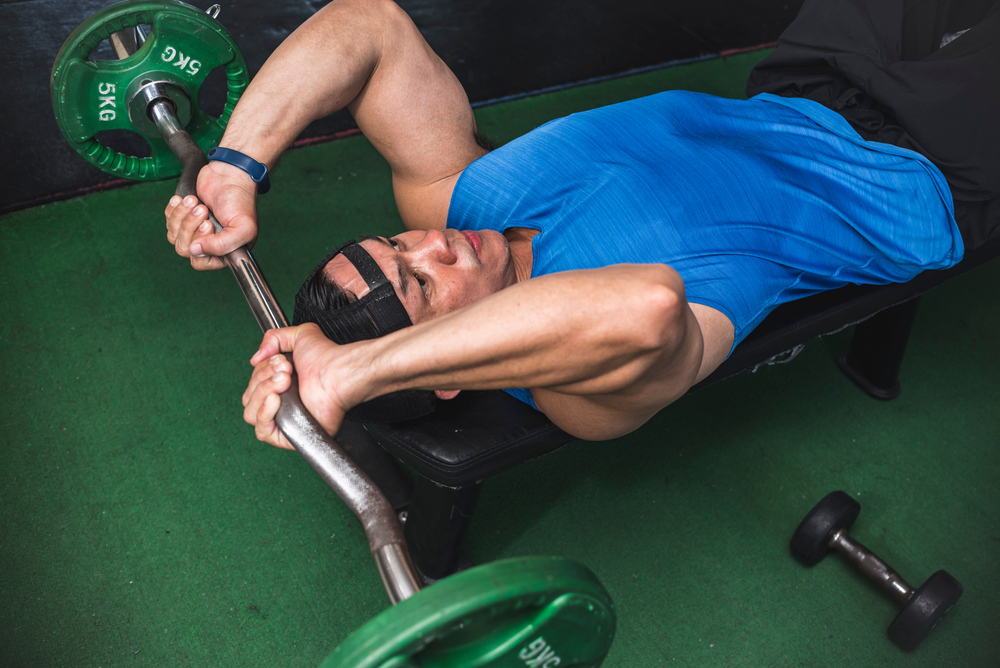EZ-bar skull crushers are a triceps isolation exercise where you lie on a flat bench and lower an EZ-bar to your forehead or slightly behind your head by bending only at the elbows, then press it back up to the starting position.
They’re effective for building triceps strength, improving pressing performance, and supporting joint stability.
Keep reading for a detailed breakdown of proper form, common mistakes, useful variations, and programming tips.
Why EZ-Bar Skull Crushers Deserve Your Attention
If bigger arms or stronger presses are on your radar, EZ-bar skull crushers should be in your rotation.
They’re not just another triceps exercise—they’re one of the most focused and joint-considerate ways to build size and strength in your upper arms.
Triceps Isolation That Actually Works
What makes EZ-bar skull crushers stand out is how directly they hit the triceps.
Unlike compound lifts that spread the workload across multiple muscles, this movement forces your triceps to do nearly all the heavy lifting.
And because your elbows stay fixed and the bar path is tight, you can dial in on the contraction without unwanted involvement from your shoulders or chest.
The shape of the EZ-bar also puts your wrists in a more natural, semi-supinated position.
That simple grip shift can reduce joint strain compared to a straight bar, especially over time or under heavier loads.
It’s a subtle change that makes a big difference in comfort and longevity.
Strength Carryover to Bigger Lifts
The triceps play a major role in extending your arms during pressing movements—think bench press, overhead press, and dips.
Weak triceps often become the limiting factor when pushing heavier weight.
Building them with a strict isolation movement like EZ-bar skull crushers creates a stronger lockout and better overall pressing mechanics.
You’ll notice the difference when you’re no longer getting stuck halfway up during a bench press.
Joint-Friendly Mechanics
Joint health doesn’t get enough attention in most triceps discussions, but it matters—especially if you’re lifting consistently.
EZ-bar skull crushers help support elbow and shoulder stability because they require controlled movement and strict form.
You’re forced to slow things down, reduce momentum, and focus on precision, which keeps stress where it belongs—on the muscles, not the joints.
This movement is also easy to adjust. Small tweaks in arm angle or grip width can reduce discomfort without sacrificing effectiveness.
And if you’re dealing with nagging elbow pain, switching to dumbbell or resistance band variations (which mimic the same mechanics) can help you keep training without setbacks.
A Go-To for Long-Term Progress
EZ-bar skull crushers aren’t just effective—they’re versatile.
Whether you’re chasing size (hypertrophy), strength, or endurance, you can easily adjust rep ranges and loads to match your goals.
They’re also easy to integrate into most upper-body or arm-focused routines.
You don’t need a complicated setup or specialized equipment—just a bench, an EZ-bar, and some focus.
And perhaps most importantly, they’re a movement you can stick with.
The simple setup, customizable variations, and reduced strain on joints make them ideal for building progress over months and years—not just weeks.
So if you’re looking for a triceps exercise that delivers noticeable results without the wear and tear of more aggressive lifts, EZ-bar skull crushers deserve your attention.
Don’t Sabotage Your Gains: Common Mistakes (and How to Fix Them)
Even a well-designed movement like the EZ-bar skull crusher can quickly lose its effectiveness if you cut corners on form or fall into bad habits.
The good news? Most of the common mistakes are easy to spot and even easier to fix once you know what to look for.
Elbows That Wander Off Course
Letting your elbows flare out is one of the most common and costly mistakes.
It shifts stress away from the triceps and toward the shoulders, which defeats the purpose of the exercise.
You might feel like you’re getting a deeper range or more power, but you’re actually just taking the focus off the muscle you’re trying to grow.
Instead, keep your elbows pointed forward and close to your head throughout the entire movement.
You don’t need to clamp them in rigidly—just avoid letting them drift wide.
A slight inward angle is fine as long as the upper arms stay mostly locked in place.
Trying to Lift Too Much, Too Soon
There’s a point where more weight becomes less effective, especially with skull crushers.
Loading the bar too heavy usually leads to flared elbows, incomplete reps, or using momentum to swing the bar back up.
It also raises the risk of elbow and wrist strain, not to mention the obvious danger of a bar slipping too close to your face.
Start with a weight that lets you move smoothly and under control through the entire range of motion.
If you can’t get a full set of 8–12 reps without form breaking down, scale back the load.
You’ll get better long-term results by training the muscle, not your ego.
Speeding Through the Descent
A fast descent might feel efficient, but it takes away from what makes this exercise so effective—time under tension.
Worse, rushing the negative phase can make it hard to control the bar’s path, putting your face, forehead, or skull at unnecessary risk.
Lower the bar slowly and with intent. Think of the descent as just as important as the press.
You should feel the triceps stretch as the bar moves down, and resist the urge to bounce or swing it back up.
Cutting the Range of Motion Short
Triceps don’t grow well on half reps.
If you stop the bar too high or fail to fully extend your elbows at the top, you're limiting both the stretch and the contraction—key components of muscle development.
Every rep should start from full extension, descend to just above your forehead or slightly behind your head, and then press all the way back up without locking out your elbows too aggressively.
Don’t rush the top either; squeeze your triceps briefly before resetting for the next rep.
Smarter Training: Variations to Target Your Triceps from All Angles

Once you’ve nailed the basic EZ-bar skull crusher, you can start using variations to keep progress going and avoid overuse.
Each version shifts the emphasis slightly, giving you more control over how you target different parts of the triceps and how the movement feels on your joints.
Incline skull crushers are an easy first adjustment.
By lying on an incline bench instead of a flat one, you change the angle of your upper arms relative to your torso.
This shift places more stretch on the long head of the triceps—the largest part that often needs extra attention.
You’ll feel the difference quickly, especially at the bottom of the movement where the muscle is under more tension for longer.
Just keep your elbows slightly behind your shoulders as usual, and control the bar on the way down to get the full benefit.
If you’re dealing with wrist discomfort or simply want to allow for more natural movement, dumbbell skull crushers are a great alternative.
Using individual weights lets each arm move independently, which means your wrists and elbows can follow a path that feels right for your body.
This freedom can reduce joint strain and encourage a deeper stretch at the bottom of each rep.
It’s also a solid option if you want to correct strength imbalances between arms.
Resistance band skull crushers offer a totally different feel and are particularly useful if you’re managing joint issues or training at home.
Bands create variable resistance, which means the tension increases as you press to the top.
This keeps your triceps under load even in the lockout phase where free weights sometimes go slack.
They’re also easy on the joints because the resistance isn’t as aggressive at the bottom—where elbows are most vulnerable.
Plus, bands are easy to adjust and convenient to travel with or set up quickly.
You don’t need to stick with just one variation either.
Rotating between them over the course of a training cycle can reduce wear and tear, keep workouts interesting, and help you build well-rounded triceps.
Just be sure to match the variation to your training goal—whether that’s maximizing stretch, improving stability, or managing joint stress.
Programming Tips: How to Include EZ-Bar Skull Crushers in Your Workout
To get consistent results from EZ-bar skull crushers, you need more than just good form—you need a smart plan.
Knowing how often to train them, how many reps to do, and where to place them in your routine can make a big difference in progress.
For most people, training skull crushers once or twice per week is enough.
If you follow a split where arms have their own day, you can work them in both sessions.
If your triceps are hit during push or chest days, adding them once as a focused isolation move works well.
The key is to allow enough recovery time between sessions—especially since your triceps also get worked in pressing movements.
When it comes to volume, 3 to 4 sets of 8 to 12 reps is a solid default.
That rep range hits the sweet spot for hypertrophy, giving your muscles enough time under tension to grow without overly taxing your joints.
If your focus is strength, lower reps (like 5–8) with heavier weight can be effective, but only if your form stays sharp.
For muscle endurance or active recovery, going up to 15 reps with lighter weight works too—just don't treat it as an afterthought.
To get even more out of your session, consider using skull crushers in a superset with biceps work, like hammer curls.
This push-pull setup not only saves time, but it also helps balance arm development and improves blood flow between sets.
You’ll feel the burn and keep your intensity high without adding extra time to your workout.
Whether you’re building your arms from scratch or fine-tuning your upper-body training, the real value of EZ-bar skull crushers comes when they’re part of a well-thought-out plan.
Stick to a consistent schedule, match volume to your goals, and experiment with pairing them with complementary movements—you’ll see better results and stay injury-free.
Who Should Use EZ-Bar Skull Crushers (and Who Shouldn’t)
EZ-bar skull crushers are a valuable addition to many training programs, but they aren’t a one-size-fits-all solution.
Who benefits the most—and who might be better off starting elsewhere—depends on experience level, training goals, and joint health.
They’re especially effective for intermediate to advanced lifters who already have a solid foundation in weight training and are looking to bring up their triceps.
If you’ve been lifting consistently and your pressing strength has plateaued, this exercise can help target weak points—particularly the lockout phase of movements like the bench press.
They’re also ideal if you’re training for size, since they isolate the triceps more directly than most compound lifts.
On the other hand, beginners might want to hold off or modify how they use skull crushers early on.
While the movement looks simple, it requires good body control, coordination, and strict form.
If you’re just starting out, it’s smarter to begin with more controlled isolation work like rope pushdowns or overhead extensions, which are easier to learn and manage under lighter loads.
Once your form and joint stability are in place, transitioning to skull crushers becomes much more effective—and safer.
Conclusion
EZ-bar skull crushers are a reliable, focused way to build stronger, more defined triceps.
When performed with proper form and smart programming, they support both muscle growth and pressing strength.
Start light, stay consistent, and use variations when needed to keep your progress moving forward.
If you have a history of elbow discomfort or joint sensitivity, standard EZ-bar skull crushers might aggravate those areas, especially if the weight is too heavy or the range of motion is forced. In that case, switching to dumbbell or resistance band variations can offer the same benefits without the same strain. These versions give your joints more freedom to move naturally and can reduce irritation while still training the triceps effectively.







